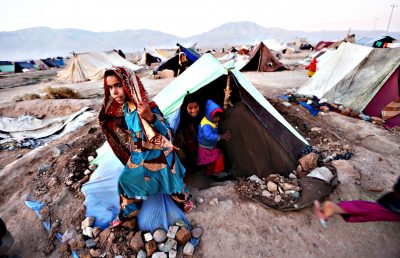Janus Engel
By
Amnesty International
The number of Afghans who have fled violence and remained trapped in their own country – where they live on the brink of survival, has dramatically doubled over the past three years, a new report by Amnesty International highlights.
A staggering 1.2 million people are internally displaced in Afghanistan today, a dramatic increase from some 500,000 in 2013. Afghans already form one of the world’s largest refugee populations, with an estimated 2.6 million Afghan citizens living beyond the country’s border.
Amnesty International’s new report, ‘My Children Will Die This Winter’: Afghanistan’s Broken Promise to the Displaced, casts fresh light on the country’s forgotten victims of war who have fled their homes but remain displaced within the country’s borders.
[youtube= https://youtu.be/8yef-w_0qRs&w=550&h=400]
“While the world’s attention seems to have moved on from Afghanistan, we risk forgetting the plight of those left behind by the conflict,” said Champa Patel, South Asia Director at Amnesty International.
“Even after fleeing their homes to seek safety, increasing numbers of Afghans are languishing in appalling conditions in their own country, and fighting for their survival with no end in sight.”
Amnesty International’s research found that despite the promises made by successive Afghan governments, internally displaced people (IDPs) in Afghanistan continue to lack adequate shelter, food, water, health care, and opportunities to pursue education and employment.
“Even an animal would not live in this hut, but we have to,” Mastan, a 50-year-old woman living in a camp in Herat, told Amnesty International. “I would prefer to be in prison rather than in this place, at least in prison I would not have to worry about food and shelter.”
Their situation has dramatically worsened over the past years, with less aid and essentials like food available. A new National IDP Policy launched in 2014 could be a lifeline to those displaced but has hardly been implemented at all – stymied by alleged corruption, lack of capacity in the Afghan government and fading international interest.
Forced evictions
Despite Afghan authorities promising to improve the conditions IDPs are living in, Amnesty International found that forced evictions – from both government and private actors – is a daily threat.
On 18 June 2015, the first day of Ramadan, a group of armed men in military style threatened to bulldoze shelters at the Chaman-e-Babrak camp in Kabul. An elderly man protested the attempted forced eviction, appealing to nearby police officers to halt the bulldozing. He was beaten by the armed men, triggering a demonstration.
In response, residents said that police and the armed men opened fire on the IDPs, killing two people and injuring 10. One of the injured was a 12-year-old boy. No investigation was carried out and no one has been held to account.
Jalil Rezayee
A life on the brink of survival
Most IDP communities lack access to basic health care facilities. With only mobile clinics, operated by NGOs or the government, occasionally available, IDPs are often forced to seek private health care that they cannot afford.
“If we are ill, then I have to beg and find some money to go to the private clinics,” one 50-year-old woman in Herat told Amnesty International. “We have no other choice.”
As people without any stable source of income, IDPs can find themselves burdened with large amounts of debt. In one case, a father told Amnesty International that he had to borrow 20,000 Afs (US$292) to pay for an operation for his son. “[This is] an enormous sum of money for us,” the father said.
Despite the assertion that IDPs have a right to request and receive food, water and adequate clothing in the 2014 policy and their obligations under international law, the Afghan government has failed to provide reliable accessibility to basic living necessities. People are forced to make long, daily trips to gather water and struggle to find one daily meal.
“Food is a luxury here, no one can afford it,” Raz Muhammad, a community leader in Kabul’s Chaman-e-Barbak camp said. “We mostly live off bread or spoiled vegetables from the market. The last time we received food assistance was ahead of last winter when we got three sacks of wheat.”
Since being forced to leave their homes, IDP children’s education has been interrupted and adults have been reduced to chronic unemployment.
“Internally displaced persons should not suffer discrimination of any kind,” said Champa Patel. “They should be provided with the same access to education and employment opportunities that other Afghans are.”
The IDP policy states that no displaced child should be denied an education even if they can’t afford essentials like school books, uniforms and other educational supplies.
In practice, however, the financial burdens borne by IDPs have meant that children often work to support their families, such as by washing cars, polishing shoes for money, and collecting plastic bags to resell.
“The financial burdens on displaced families are compounded,” said Champa Patel. “They have lost the traditional sources of their livelihoods, and only have few opportunities for informal work, creating circumstances where women are excluded, and children are being exploited and not educated.”
The IDP Policy: A failed promise
The 2014 IDP Policy spells out the rights of IDPs on paper and a concrete action plan for the Afghan government to implement it. But it has not lived up to its promise and, so far, showed little benefits for those displaced.
There are many reasons for the failure to implement it – for one, there is an enormous lack of capacity and expertise in the Afghan government when it comes to IDPs. The Ministry of Refugees and Repatriation, charged with coordinating the Policy’s implementation, is badly under-resourced and has been beset by corruption allegations for years.
At the same time, the international community has not stepped in as much as it could where the Afghan government has been unable to. With other crises grabbing global attention and donor money, aid to Afghanistan is dwindling. The UN has asked for US$ 393 in humanitarian funding for Afghanistan in 2016 –the smallest figure in years despite the dire humanitarian situation. By May, less than a quarter had been funded.




No Comments Yet!
You can be first to comment this post!